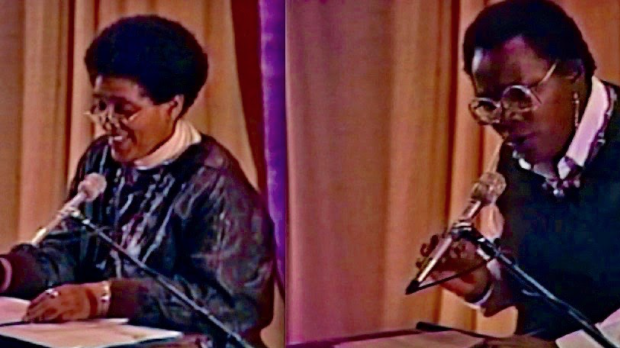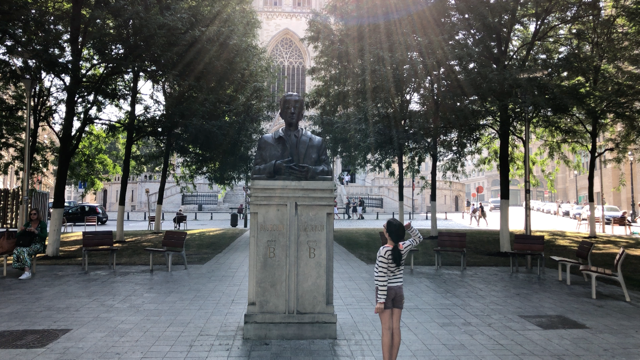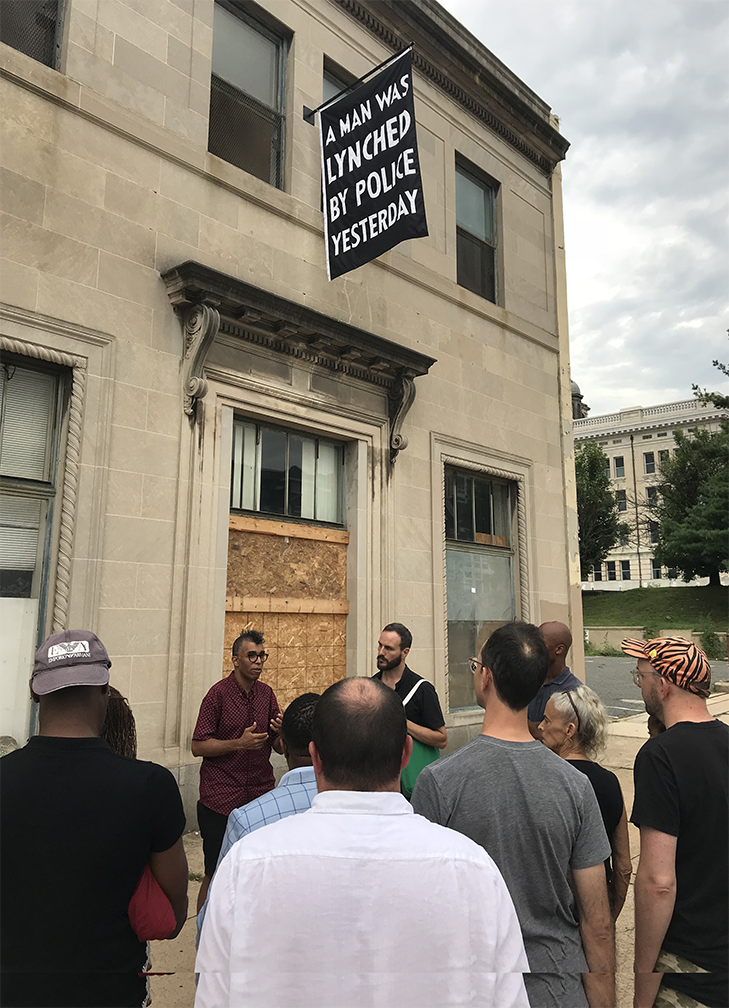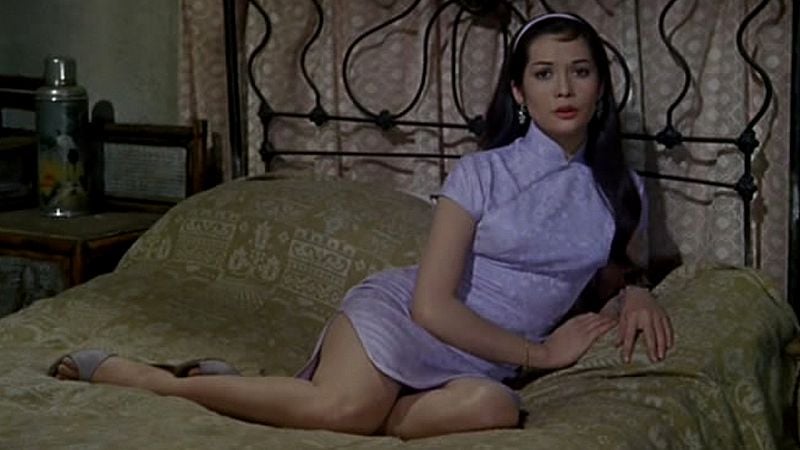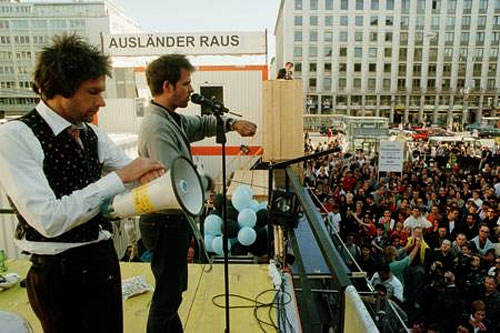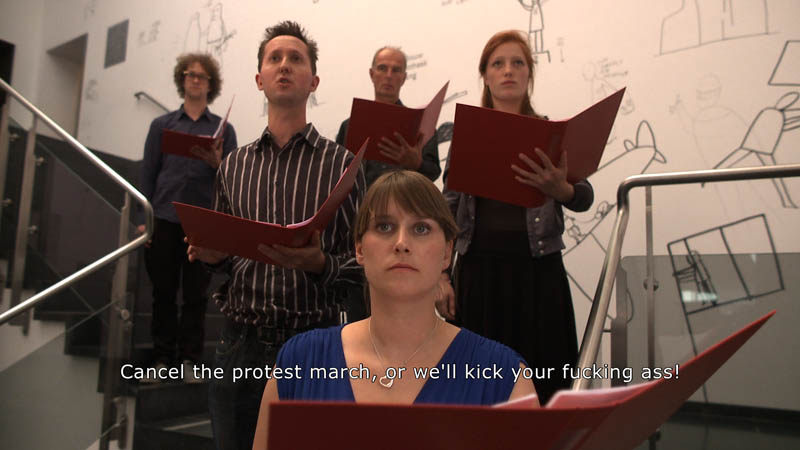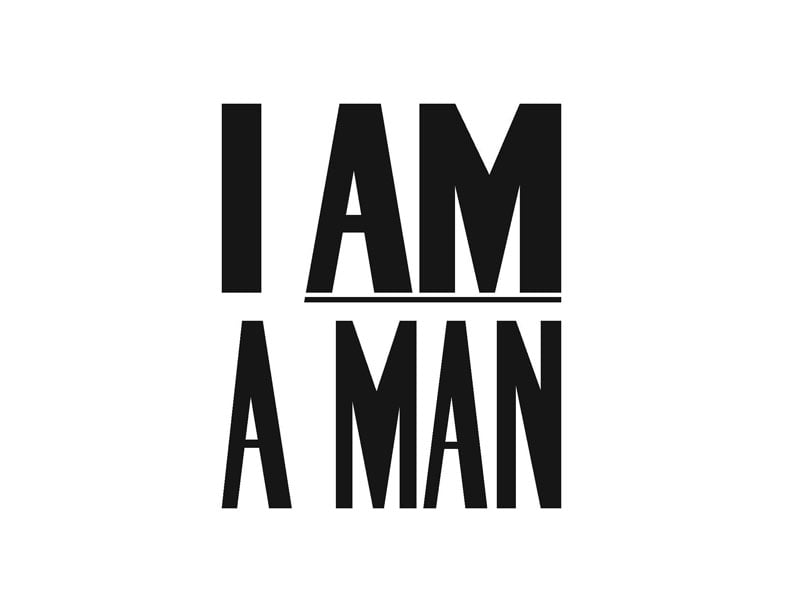
© » KADIST
Yétúndé Olagbaju
Yétúndé Olagbaju’s On becoming a star series recuperates the figure of ‘Mammy’, a stereotype rooted in American slavery that typically depicts a larger, dark skinned woman as a maternal presence, often within a domestic setting, and typically taking care of white children. After being referred to as a Mammy during their undergraduate degree, Olagbaju began exploring the figure in 2016 as a means of healing. Olagbaju’s first presentation on this topic was a book called Black Collectibles: Mammy and Friends (1997) that sells tchotchkes—like salt and pepper shakers or figurines—of the racist mammy image taking different forms, from which Olagbaju exorcised the Mammy images by carefully cutting them out of the book with a razor blade.

© » KADIST
Emma Wolukau-Wanambwa
A short video about Tate Modern by Emma Wolukau-Wanambwa depicts just two shots, both featuring the artist. The first scene portrays Wolukau-Wanambwa in a close-up frontal view, dressed in black, standing silently against a worn white wall. Through subtitles, the artist recounts her experience of participating in a workshop on the top floor of the museum.

© » KADIST
Rahima Gambo
“ I think we are oversaturated, filled to the brim with images in our inner subconscious eye. Towards the end of 2020, I was feeling very much that I couldn’t take in any more information visually. That was when I made Instruments of Air.

© » KADIST
Jared Owens
Hog feed 102 is an exemplary work by Jared Owens that combines two of the artist’s primary signatures: the use of soil smuggled out of the grounds at F. C. I. Fairton, a prison in which Owens was incarcerated, and the stowage diagram of the Brookes slave ship. This diagram from 1788 is a logistical blueprint of how to pack Black bodies efficiently, in tiered serial form, into the hold of a ship. Merging these vocabularies, Owens has laced a burlap sack for pig feed into the work to advance a multi-layered commentary on American prisons as ostensible ‘human farms’ that dehumanize inmates by turning them into a commodity for the prison industrial complex.

© » KADIST
Leila Weefur
Leila Weefur’s two-channel video installation Between Beauty & Horror focuses on the sensorial and somatic experiences that give Blackness a distinct and inherently racialized materiality. The narrative structure of Between Beauty & Horror operates on dream logic; interspersed among the dream sequences of the video are moments that fluidly shift between violence, playfulness, tenderness, and of course, beauty and horror. Weefur’s work poses many questions about the Black experience, but it offers no easy answers.

© » KADIST
Joe Namy
Joe Namy’s Half Blue is an installation consisting of a video, a sound, and a sculpture, that triangulates a personal experience of the artist’s cousin Khalid Jabara, who was murdered by hate crime in Tulsa, Oklahoma, U. S. A in 2016. An event that garnered international attention, Jabara’s murder led to the Jabara-Heyer NO HATE Act passed by US Congress in 2021. The act was named after Jabara and Heather Heyer, two hate crime victims whose murders were prosecuted as hate crimes but not reported in hate crime statistics.

© » KADIST
American Artist
From suicides, to gang violence, to the epidemic abuse of force by police departments (predominantly against Black men), to school and mass shootings, there is perhaps no more urgent issue in the United States than gun control. The color blue is a proxy for both sadness, and a color that is emblematic of American law enforcement services. I Am Blue, 1 by American Artist is a sculpture that fuses a school desk with a ballistic shield.

© » KADIST
Ghita Skali
The Invaders by Ghita Skali is a tale that bites you. This short film, staged in the first few months of the COVID-19 pandemic, in a broader context of increasingly xenophobic and racist policies in western countries, uses comedy to flip the stigma. First, Skali sets the scene: Once upon a time, a virus came and changed the plan .

© » KADIST
Doreen Lynette Garner
Known But to God: The Dug Up, Dissected, and Disposed for the Sake of Medicine by Doreen Lynnette Garner is a small, suspended sculpture composed of glass, silicone, steel, epoxy putty, pearls, Swarovski crystals, and whiskey. At once attractive and repulsive, the sculpture combines objects of adornment with what appears to be viscera. The sculpture’s curious delicacy evokes a ritualistic catharsis, in response to persistent forms of medical racial violence and objectification for Black people in America and around the world.

© » KADIST
Goddy Leye
In Goddy Leye’s installation work The Beautiful Beast , a video is projected onto a gold-colored wooden box filled with sesame seeds. The sesame seeds look like pixels underneath the video, suggesting the texture of animation. The artist portrays a strange man who writhes on the ground like a beast against this ‘pixelated’ field.

© » KADIST
Indira Allegra
Open Casket IX is an installation by Indira Allegra that combines traditional materials of memorial—tombstones, mausoleums, and caskets—with contemporary expressions of grief. The work is a memorial for people who have lost loved ones to police violence. It is part of Allegra’s Open Casket series, which is concerned with the need to recognize grieving as a collective responsibility, rather than an individual misfortune to be shouldered by one affected person or family.
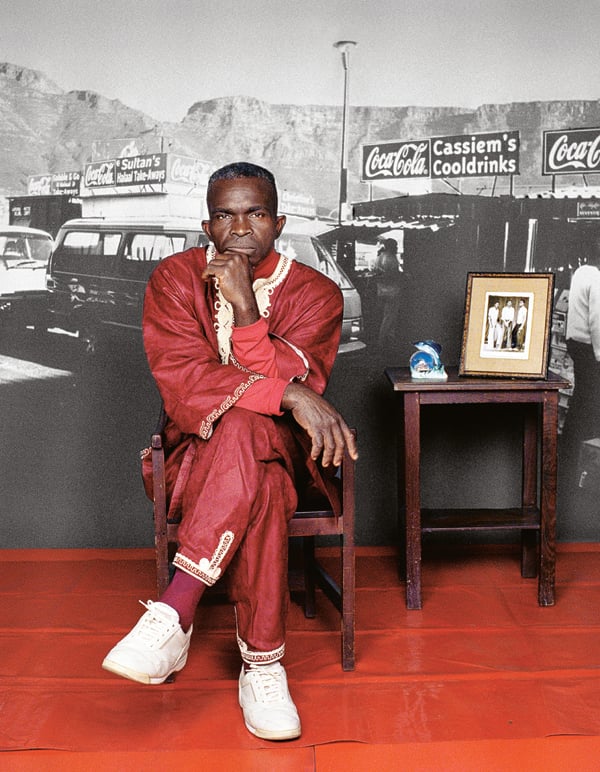
© » KADIST
Sue Williamson
In her 2003 series “Better Lives”, Sue Williamson explores stories of immigrants in search of a better life in a historically contentious South Africa. In an attempt to address and confront xenophobia in South African history, Better Lives series subverts racism and prejudice by emphasizing the immigrant as human, and thus gives the subjects a voice. “Better Lives: Richard Belalufu” tells a tale of surviving in a hostile South Africa through the undercurrent reflections on violence, abuse and the difficulty of finding home as an immigrant.

© » KADIST
Leah Gordon
The Caste Portraits Series by Leah Gordon investigates the practice of grading skin color from black to white, which marked the extent of racial mixing in 18th century Haiti. Médéric Moreau de St Mery (1750-1819), a French créole slave owner and freemason living in Saint Domingue (now Haiti), created a taxonomy of race classifying skin color from black to white using names derived from mythology, natural history, and bestial miscegenation. His Description topographique, physique, civile, politique et historique de la partie française de l’isle Saint-Domingue (1789) hierarchizes 128 possible combinations of black-white miscegenation into nine categories (the sacatra, the griffe, the marabout, the mulâtre, the quarteron, the métis, the mamelouk, the quarteronné, and the sang-melé).

© » KADIST
Gaëlle Choisne
Entre Chien et Loup is an installation incorporating a variety of media: rubber, discs, feathers and confetti that the artist weaves, sews and glues together. Influenced by Mike Kelley’s Memory Ware series, the artist creates an object-memory from found materials. The found objects used recall the artist’s mother – it is somehow her portrait, her cape-.

© » KADIST
Tracey Rose
“Maqe II” is at first glance a romantic image of three diaphanous angels hovering in the luminous sky over a South African township. A closer inspection reveals that the apparition is the appropriated figure of Marie Antoinette from the artist’s Ciao Bella series (2001) with the addition of a butchered cake. The figure is Rose herself dressed in costumed made of trash bags holding a haunting paper mâché mask.

© » KADIST
Daniela Ortiz
The Rebellion of Roots by Daniela Ortiz depicts a series of situations in which tropical plants, held hostage in the botanical gardens and greenhouses of Europe, are protected and nurtured by the spirits of racialized people who died as a result of European racism. The work is divided into four short stories: About Afghanistan and heroin , About Exposition Colonial and cow , About Jardin d’acclimatation and potato , and About Vietnam . The series of 14 painted panels draw upon the aesthetic of ex-votos, a genre of traditional religious folk painting that acts as a tribute for divine intervention in response to personal tragedy.

© » KADIST
Lubaina Himid
Drawing & Print (Drawing & Print)
In 2007 Lubaina Himid began a series of works she later called Negative Positives: The Guardian Archive (2007-2017). What started out as a one-year project, in the year celebrating the bicentenary of the abolition of slavery in the UK, continued for a decade. Taking a page or a spread of The Guardian (the most liberal newspaper in the UK and her newspaper of choice), Himid sought to expose the unconscious bias manifested in a paper that prides itself on its non-discriminatory policies.

© » KADIST
Dread Scott
Drawing & Print (Drawing & Print)
This screen-print by Dread Scott titled Imagine a World Without America shows a map without the landmass that is the USA, as if the continents have drifted, or as if it never existed in the first place. Artist Dread Scott’s work is founded upon challenging “American patriotism as a unifying value,” and as such he claims that it is necessary to “burn the US Constitution (an outmoded impediment to freedom), and position the police as successors to lynch mob terror.” Perhaps one must imagine a structurally different world to produce new and freer modes of thought. While not explicitly related to Afro-Futurism, one of the key sub-genres of science-fiction and related thought is speculative revisionism; asking ‘how would the world be different if X never happened?” This modest work is a call to our daily imaginary, an invitation to zoom out to the scale of the global human condition, and implicitly America’s role in trade, war, cultural exchange, and the spread of western values.

© » KADIST
Ho Rui An
Embracing the conflicting negative and positive affect of the horror genre, Ho Rui An’s film Student Bodies is a self-described work of “pedagogical horror,” that organizes social, political, and economic events in Asia around the motif of the student body. Bound together by a suspenseful, eerie soundtrack, the film temporally cycles through its separate, though thematically interrelated, phenomena and events centering Asian students. Using the student body motif as a human signifier of varied connotations, the film follows phenomenon ranging from the Ch?sh?

© » KADIST
Lubaina Himid
Drawing & Print (Drawing & Print)
In 2007 Lubaina Himid began a series of works she later called Negative Positives: The Guardian Archive (2007-2017). What started out as a one-year project, in the year celebrating the bicentenary of the abolition of slavery in the UK, continued for a decade. Taking a page or a spread of The Guardian (the most liberal newspaper in the UK and her newspaper of choice), Himid sought to expose the unconscious bias manifested in a paper that prides itself on its non-discriminatory policies.

© » KADIST
Titus Kaphar
Although the objects depicted in Titus Kaphar’s diptych 2016/1963 might not be immediately recognizable, the work’s title and the inscriptions ‘Alabama 1963’ and ‘North Dakota 2016’ reveal their use as tools of brutal force. The work with the inscription ‘Alabama 1963’ is a painting of the nozzle of a high-pressure water jet that the Birmingham Police used against black protesters, including children, during a non-violent campaign against racial segregation led by Martin Luther King JR. during the civil rights movement. The second painting depicts the nozzles used against protestors that in 2016 opposed the plans to build the Dakota Access pipeline near the Standing Rock Indian Reservation, many of whom were seriously hurt and left soaking wet during freezing temperatures.

© » KADIST
Karla Dickens
Karla Dickens’s collage Beneath the skim board addresses issues of discrimination and racism towards Indigenous communities in Australia through a constellation of historical and current events. Dickens spent over a year collecting and modifying ubiquitous objects into sculptural collages that commemorate former circus performers of Indigenous Australian descent. Assembled from various fabrics, knick-knacks and other materials, these frenetic compositions celebrate the campy glamour of circus performers, but also articulates the hidden mistreatment experienced by the performers, and more broadly, the lives of Indigenous communities in Australia.
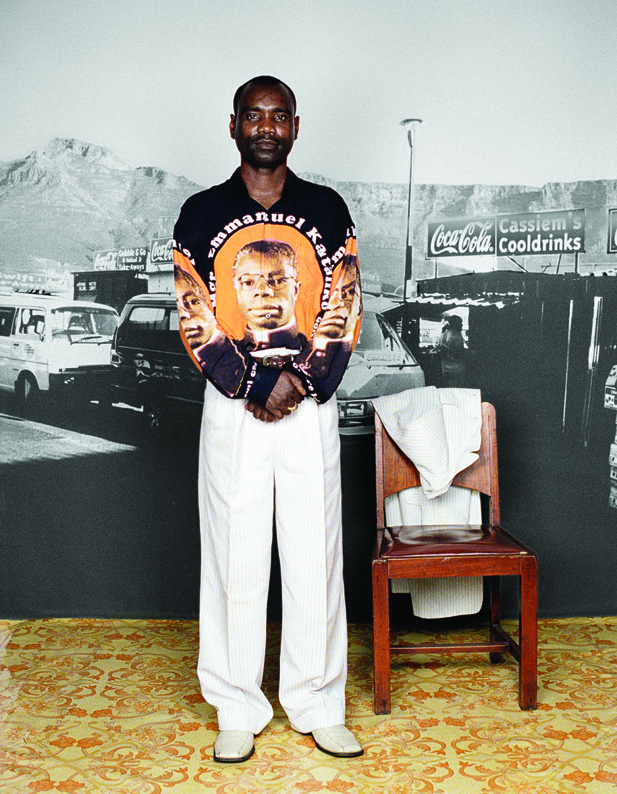
© » KADIST
Sue Williamson
In her 2003 series “Better Lives”, Sue Williamson explores stories of immigrants in search of a better life in a historically contentious South Africa. In an attempt to address and confront xenophobia in South African history, Better Lives series subverts racism and prejudice by emphasizing the immigrant as human, and thus gives the subjects a voice. “Better Lives: Richard Belalufu” tells a tale of surviving in a hostile South Africa through the undercurrent reflections on violence, abuse and the difficulty of finding home as an immigrant.

© » KADIST
Dawoud Bey
On 15 September 1963 members of the Ku Klux Klan blew up the 16th Street Baptist Church in Birmingham Alabama up using dynamite. Four African American girls were killed, and 22 other people were injured. Two African American boys were killed in related violence that day.

© » KADIST
Steffani Jemison
In Escaped Lunatic , a steady stream of figures run across the screen, sprinting, jumping, and rolling through the streets of Houston. The work is part of a trilogy that borrows its narrative structure from early-20th-century cinema. The artist employs the chase genre, which has often depicted African Americans in scenes of flight from various forms of authority.

© » KADIST
Martine Syms
Her 2016 video installation quotes the sitcom-as-form and also draws from a 1907 comedic short, Laughing Gas. Syms’s 4-channel installation follows the central character (an aspiring artist also named Martine Syms) on a journey home from the dentist after receiving “laughing gas.” Mixing multiple points of view, clips borrowed from TV, as well as layers of comedy, fiction, reality, and critique, Syms’ work also delves into issues of race, culture, and representation. For Los Angeles-based Martine Syms, popular culture, television, and the cultural histories woven through both are starting points for her interdisciplinary art practice.

© » KADIST
David Goldblatt
David Goldblatt’s “Boksburg series” is a telling portrait of the small town that became a notorious symbol of racism in South Africa. The photographic essay negotiates the troublesome landscape of the apartheid through capturing the intimate in-between moments that are seemingly inconsequential and visually inoffensive. However, it is in this series that Goldblatt provides a candid insight into the white communities during the apartheid.

© » KADIST
Yan Xing
The title of this series – Two videos, three photographs, several related masterpieces and American art – is paradoxical, suggesting the work is conceived in relation to its medium and a situation in art history and the region of the world in which it was made. Paradoxical but in the end, often true of the way in which art history is written. The presence of black men and the term “American Art” brings us back to Robert Mapplethorpe’s Black Book .

© » KADIST
Daniel Joseph Martinez
Martinez’s sculpture A meditation on the possibility… of romantic love or where you goin’ with that gun in your hand , Bobby Seale and Huey Newton discuss the relationship between expressionism and social reality in Hitler’s painting depicts the legendary Black Panther leaders Huey P. Newton and Bobby Seale. By using Carrara marble, a material usually associated with heroic public sculptures, Martinez casts the history of African-American revolutionaries into the artistic tradition of monumentality. Like the artist’s earlier work included in the 1993 Whitney Biennial, an interactive piece made up with pins that read, “I CAN’T IMAGINE EVER WANTING TO BE WHITE,” A meditation on the possibility… continues Martinez’s effort to expose cultural contradictions and increase public awareness.
Hank Willis Thomas
- location: New York, New York
- year born: 1976
- gender: male
- nationality: American
- home town: Plainfield, New Jersey
Lubaina Himid
- location: Zanzibar, Tanzania
- year born: 1954
- gender: female
- nationality: Tanzanian
Sue Williamson
Sue Williamson (b...
Leah Gordon
Leah Gordon is an artist, curator, and writer, whose work considers the intervolved and intersectional histories of the Caribbean plantation system, the Trans-Atlantic Slave Trade, the Enclosure Acts and the creation of the British working-class...
Karla Dickens
Karla Dickens is a Wiradjuri artist whose work spans sculpture, textiles, poetry, painting, photography, and found material collage...
Ho Rui An
The artist, writer, and researcher Ho Rui An probes histories of globalization and governance, performing a detournement of dominant semiotic systems across text, film, installation, and lecture...
David Goldblatt
- location: Randfontein, South Africa
- year born: 1930
- gender: male
- nationality: South African
Leila Weefur
Leila Weefur is an artist, writer, and curator whose practice considers the complexities of phenomenological Blackness through video, installation, printmaking, and lecture-performances...
Doreen Lynette Garner
Doreen Lynette Garner’s practice examines the histories and enduring effects of racial violence in the United States...
Dawoud Bey
Dawoud Bey is an American photographer and professor and Distinguished Artist at Columbia College Chicago...
Tracey Rose
Tracey Rose, (b...
Indira Allegra
Indira Allegra uses text and textile production—a combined material they designate as a “text/ile”—to embody unseen forces like memory, haunting, grief, and emotions born from trauma...
Ghita Skali
Ghita Skali is a visual artist that uses odd news, rumors and propaganda to disrupt institutional power structures such as the western contemporary art world, state oppression and government politics...
Joe Namy
Artist and musician Joe Namy’s practice encompasses sound, its history, and impact on the built environment...
Titus Kaphar
Titus Kaphar’s work is often discussed as socially and politically oriented, however, the artist describes it as a series of deeply personal responses to situations, narratives or histories...
Rahima Gambo
With a background in photojournalism, artist Rahima Gambo entered into visual art by way of long-form documentary projects...
Daniela Ortiz
In order to reveal and critique hegemonic structures of power, Daniela Ortiz constructs visual narratives that examine concepts such as nationality, racialization, and social class...
Goddy Leye
Born in 1965 in Mbouda (Cameroun), Goddy Leye was an artist, a teacher, a cultural activist and a curator based in Douala (Cameroun)...
Dread Scott
Dread Scott is an interdisciplinary artist who for three decades has made work that encourages viewers to re-examine cohering ideals of American society...
American Artist
American Artist makes experimental work in the form of sculpture, video, and software that comments on histories of race, technology and forms of knowledge production...
Yan Xing
- location: Beijing, China
- year born: 1986
- gender: male
- nationality: Chinese
- home town: Chongqing, China
Martine Syms
- location: Los Angeles, California
- year born: 1988
- gender: female
- nationality: American
- home town: Los Angeles, California
Steffani Jemison
Steffani Jemison is an interdisciplinary artist whose work considers issues that arise when conceptual practices are inflected by black history and vernacular culture...
Jared Owens
During more than 18 years of collective incarceration, Jared Owens became a self-taught artist, working in painting, sculpture, and installation, using materials and references culled from penal matter...
Emma Wolukau-Wanambwa
Emma Wolukau-Wanambwa is an artist, researcher, and convenor of the collective the Africa Cluster of the Another Roadmap School, a project fostering conversations about art and education in Africa...
Daniel Joseph Martinez
- location: Los Angeles, California
- year born: 1957
- gender: male
- nationality: American
- home town: Los Angeles, California
-
1970-1979
David Goldblatt
1979David Goldblatt’s “Boksburg series” is a telling portrait of the small town that became a notorious symbol of racism in South Africa...
-
2000-2009
Tracey Rose
2001“Maqe II” is at first glance a romantic image of three diaphanous angels hovering in the luminous sky over a South African township...
Sue Williamson
2003In her 2003 series “Better Lives”, Sue Williamson explores stories of immigrants in search of a better life in a historically contentious South Africa...
Sue Williamson
2003In her 2003 series “Better Lives”, Sue Williamson explores stories of immigrants in search of a better life in a historically contentious South Africa...
Emma Wolukau-Wanambwa
2005A short video about Tate Modern by Emma Wolukau-Wanambwa depicts just two shots, both featuring the artist...
Daniel Joseph Martinez
2005Martinez’s sculpture A meditation on the possibility… of romantic love or where you goin’ with that gun in your hand , Bobby Seale and Huey Newton discuss the relationship between expressionism and social reality in Hitler’s painting depicts the legendary Black Panther leaders Huey P...
Dread Scott
Drawing & Print
2006(Drawing & Print) This screen-print by Dread Scott titled Imagine a World Without America shows a map without the landmass that is the USA, as if the continents have drifted, or as if it never existed in the first place...
Goddy Leye
2009In Goddy Leye’s installation work The Beautiful Beast , a video is projected onto a gold-colored wooden box filled with sesame seeds...
-
2010-2019
Leah Gordon
2012The Caste Portraits Series by Leah Gordon investigates the practice of grading skin color from black to white, which marked the extent of racial mixing in 18th century Haiti...
Dawoud Bey
2012On 15 September 1963 members of the Ku Klux Klan blew up the 16th Street Baptist Church in Birmingham Alabama up using dynamite...
Hank Willis Thomas
2013The image is borrowed from protests during Civil Rights where African Americans in the south would carry signs with the same message to assert their rights against segregation and racism...
Hank Willis Thomas
Drawing & Print
2014(Drawing & Print) Shot in black and white and printed on a glittery carborundum surface, Black Hands, White Cotton both confronts and abstracts the subject of its title...
Gaëlle Choisne
2015Entre Chien et Loup is an installation incorporating a variety of media: rubber, discs, feathers and confetti that the artist weaves, sews and glues together...
Titus Kaphar
2016Although the objects depicted in Titus Kaphar’s diptych 2016/1963 might not be immediately recognizable, the work’s title and the inscriptions ‘Alabama 1963’ and ‘North Dakota 2016’ reveal their use as tools of brutal force...
Martine Syms
2016Her 2016 video installation quotes the sitcom-as-form and also draws from a 1907 comedic short, Laughing Gas...
Doreen Lynette Garner
2017Known But to God: The Dug Up, Dissected, and Disposed for the Sake of Medicine by Doreen Lynnette Garner is a small, suspended sculpture composed of glass, silicone, steel, epoxy putty, pearls, Swarovski crystals, and whiskey...
Leila Weefur
2018Leila Weefur’s two-channel video installation Between Beauty & Horror focuses on the sensorial and somatic experiences that give Blackness a distinct and inherently racialized materiality...
Indira Allegra
2018Open Casket IX is an installation by Indira Allegra that combines traditional materials of memorial—tombstones, mausoleums, and caskets—with contemporary expressions of grief...
American Artist
2019From suicides, to gang violence, to the epidemic abuse of force by police departments (predominantly against Black men), to school and mass shootings, there is perhaps no more urgent issue in the United States than gun control...
Karla Dickens
2019Karla Dickens’s collage Beneath the skim board addresses issues of discrimination and racism towards Indigenous communities in Australia through a constellation of historical and current events...
-
2020-2029
Rahima Gambo
2020“ I think we are oversaturated, filled to the brim with images in our inner subconscious eye...
Yétúndé Olagbaju
2021Yétúndé Olagbaju’s On becoming a star series recuperates the figure of ‘Mammy’, a stereotype rooted in American slavery that typically depicts a larger, dark skinned woman as a maternal presence, often within a domestic setting, and typically taking care of white children...
Daniela Ortiz
2021The Rebellion of Roots by Daniela Ortiz depicts a series of situations in which tropical plants, held hostage in the botanical gardens and greenhouses of Europe, are protected and nurtured by the spirits of racialized people who died as a result of European racism...
Jared Owens
2022Hog feed 102 is an exemplary work by Jared Owens that combines two of the artist’s primary signatures: the use of soil smuggled out of the grounds at F...







